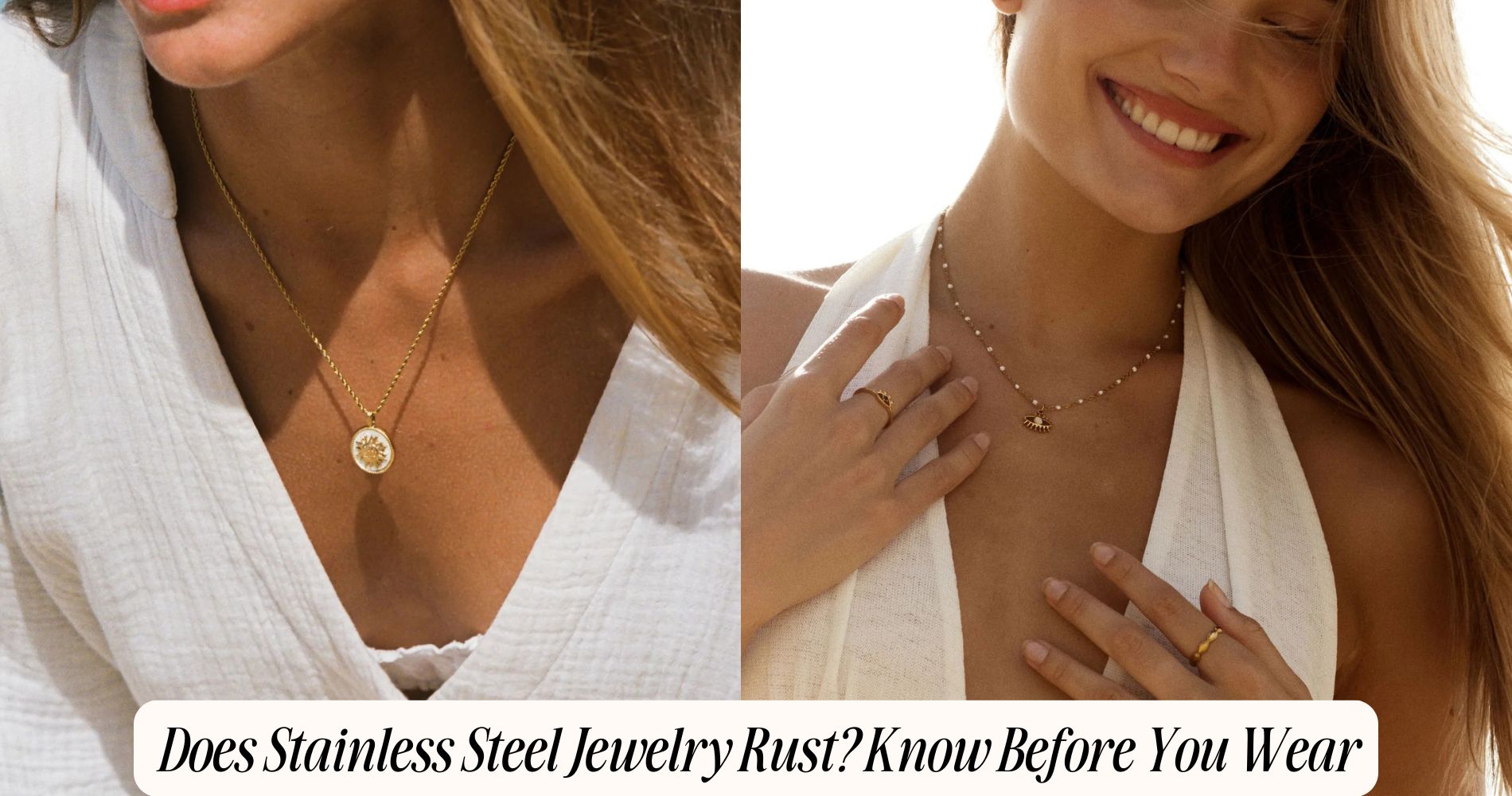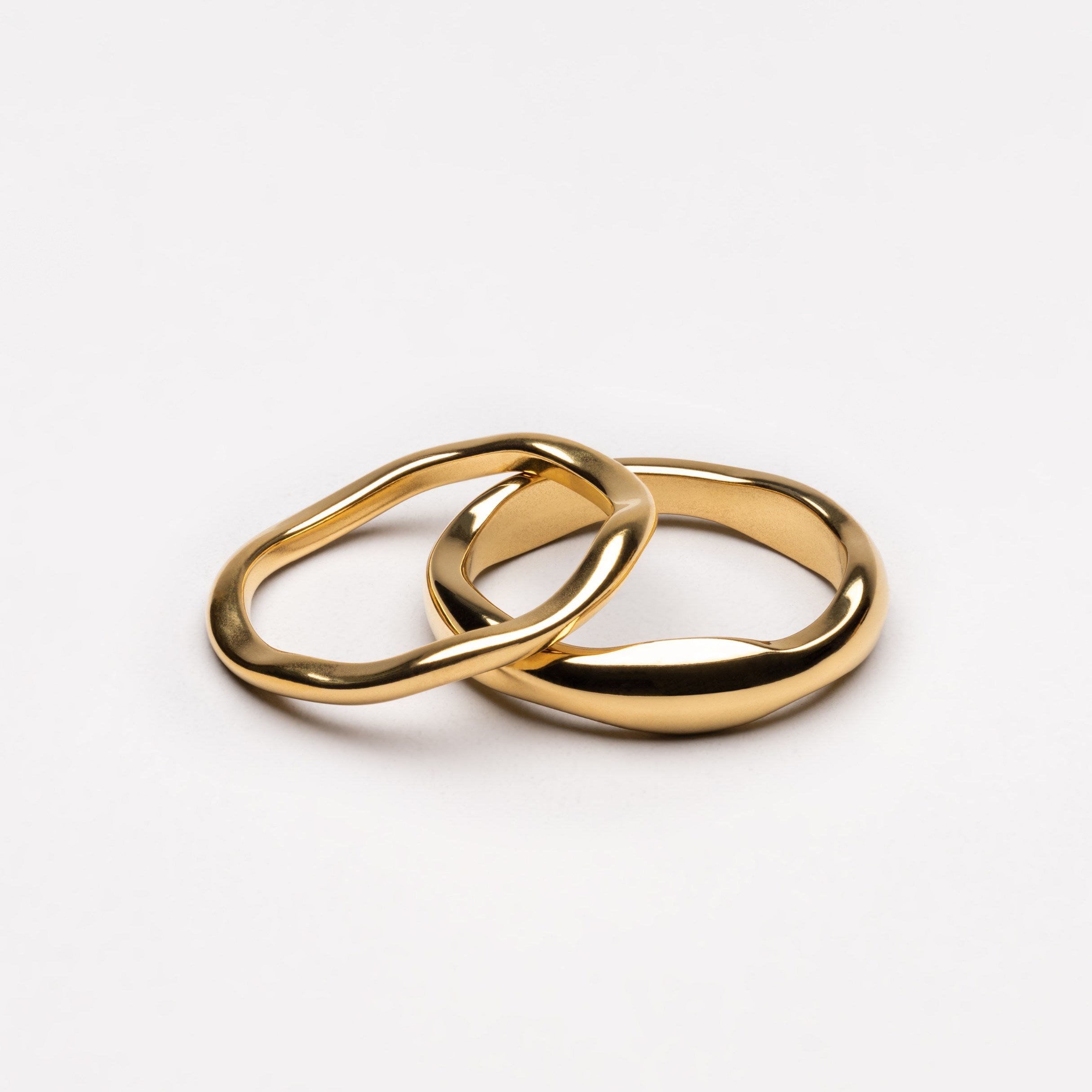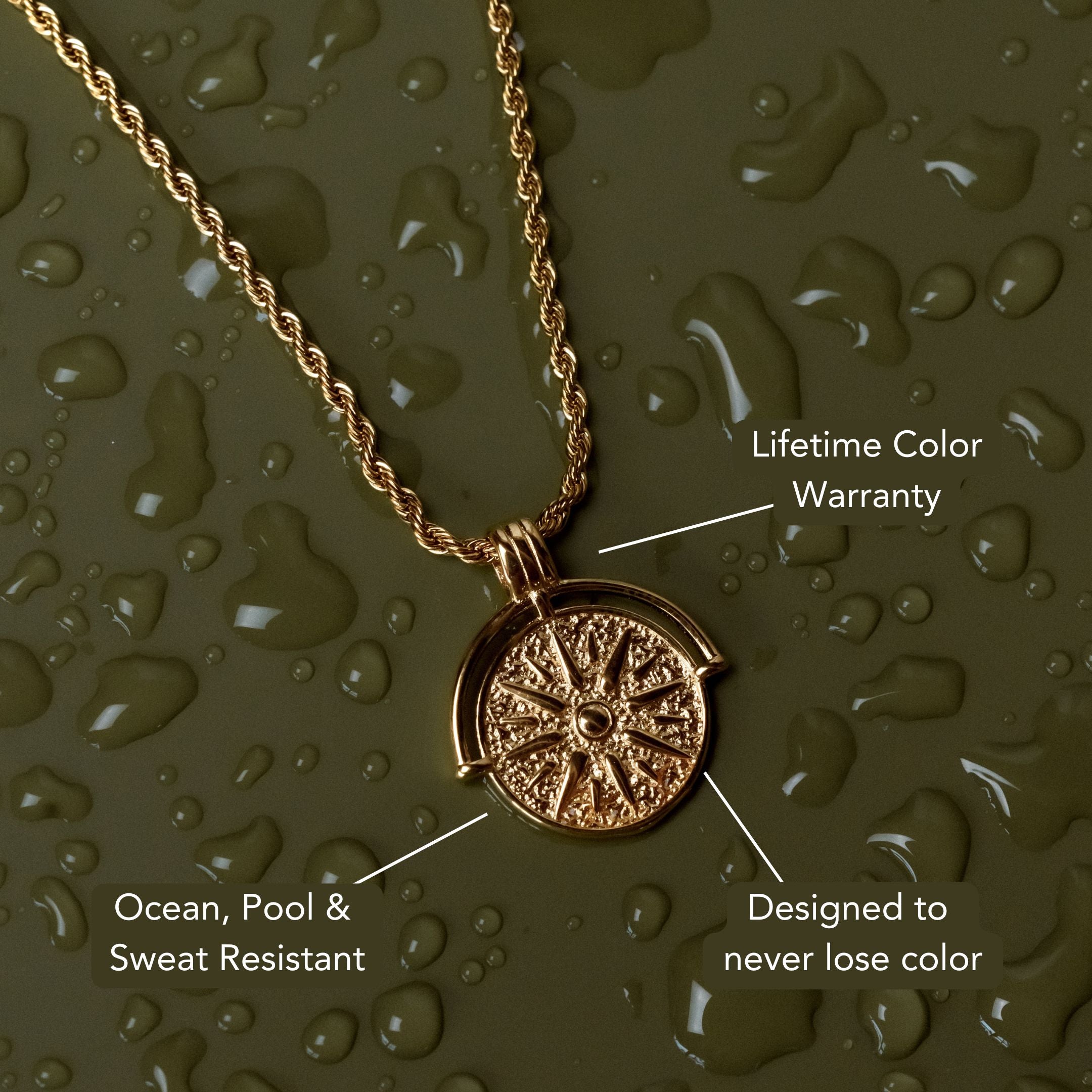
Does Stainless Steel Jewelry Rust? Know Before You Wear
Does stainless steel jewelry rust? It's a common question—and the good news is that stainless steel is highly resistant to rust thanks to its high chromium content. This element forms a protective oxide layer that blocks moisture and air, helping to prevent corrosion even with daily wear. However, if the surface gets scratched or comes into contact with salty water or harsh chemicals, that protective barrier can be compromised, increasing the risk of rust. That’s why it’s important to know which types of stainless steel offer the best durability and how to care for them—especially when choosing pieces like those in Stainless Steel Jewelry collection.
What Is Stainless Steel Jewelry?
Although many metals are used in jewelry, stainless steel stands out due to its unique alloy composition—primarily iron, chromium, and varying amounts of nickel and other elements.
When you choose stainless steel jewelry, you're opting for a material engineered for high jewelry durability and resistance to deformation. Chromium, the key alloying element, forms a passive layer that enhances surface hardness and reduces susceptibility to scratches and wear.
Additionally, the inclusion of nickel helps achieve a lustrous finish but may introduce a potential metal allergen for sensitive individuals. Stainless steel’s microstructure limits tarnish and maintains structural integrity under daily mechanical stresses.
This makes it ideal if you require a robust, lasting accessory that maintains both its mechanical and visual properties over time.
The Science Behind Stainless Steel: Why It Resists Corrosion
Stainless steel jewelry owes its impressive resistance to rust and corrosion to a precise interplay of its alloying elements at the atomic level. When you examine the alloy composition, you'll find chromium as the key element. Chromium reacts with oxygen in the environment to form a thin, stable, and adherent oxide layer on the surface of the metal.
This passive film acts as a protective barrier, preventing further oxygen and moisture from reaching the underlying iron atoms, which are prone to oxidation. The result is substantial corrosion resistance, even in challenging environments.
Additional alloying elements like nickel and molybdenum can further enhance the stability and durability of this passive layer. This scientific foundation explains why stainless steel jewelry remains lustrous and largely impervious to rust.
Common Types of Stainless Steel Used in Jewelry
When selecting stainless steel for jewelry, manufacturers primarily rely on specific grades engineered for ideal corrosion resistance, mechanical strength, and biocompatibility. The most common type you’ll encounter is 316L stainless steel, often called “surgical steel.” It contains molybdenum, which enhances resistance to chlorides and reduces the risk of allergic reactions.
Its hypoallergenic properties make it popular in both body jewelry and pieces following current fashion trends.
Another frequently used alloy is 304 stainless steel, valued for its high nickel and chromium content, providing a balance between durability and affordability. However, 304 is more likely to cause allergic reactions for sensitive skin due to its higher nickel content.
For luxury pieces, 904L stainless steel may be used, offering even higher corrosion resistance and a lustrous finish.
Factors That Can Cause Stainless Steel to Rust
Even though stainless steel jewelry is engineered for corrosion resistance, specific environmental and chemical factors can compromise its protective chromium oxide layer and initiate rust formation.
When you expose your stainless steel pieces to high humidity, saltwater, or chlorinated environments, the increased presence of chloride ions accelerates pitting corrosion and elevates oxidation risks. Sweat, lotions, and cleaning agents containing harsh chemicals can also erode the passive layer, making the metal vulnerable to rust.
Mechanical damage, such as scratches or abrasions, further disrupts the integrity of the protective film, allowing moisture and oxygen to penetrate. If you frequently wear your jewelry in adverse conditions or neglect proper cleaning, environmental factors like air pollution and temperature fluctuations can intensify corrosion processes, diminishing both appearance and structural durability.
Comparing Stainless Steel With Other Jewelry Metals
While many metals are popular in jewelry design, each exhibits distinct behaviors regarding corrosion resistance and durability. Stainless steel contains chromium, forming a passive oxide layer that resists rust and environmental exposure.
In contrast, silver tarnishes when exposed to sulfur compounds, and copper-based alloys like brass or bronze can develop verdigris in humid conditions. Gold offers strong corrosion resistance but is softer, making it prone to scratching.
Titanium displays excellent resistance to corrosion and environmental factors, similar to stainless steel, but is lighter and hypoallergenic, reducing metal allergy risks. Nickel, often used in costume jewelry, is highly susceptible to corrosion and frequently causes metal allergy reactions.
How to Spot Early Signs of Rust or Tarnish
Although stainless steel is renowned for its corrosion resistance, early detection of rust or tarnish remains essential to preserve your jewelry's integrity. You should routinely examine your pieces for subtle changes in surface appearance.
Initial warning signs include minor discoloration spots, often appearing as yellowish or brownish marks on high-contact areas. These spots indicate localized breakdown of the passive chromium oxide layer, compromising the alloy’s protective barrier. Patina development may also present as a dull, uneven sheen, rather than the expected bright metallic luster.
Use magnification to inspect crevices and clasp regions, as they’re more susceptible to moisture retention. If you observe any pitting or roughness, that’s a key indicator of incipient corrosion—prompt identification allows you to mitigate further degradation before it becomes irreversible.
Tips to Prevent Rust on Stainless Steel Jewelry
Proper care protocols considerably reduce the risk of rust formation on stainless steel jewelry by maintaining the integrity of the alloy’s passive oxide layer. You should limit exposure to chlorinated water, high humidity, and harsh chemicals, as they accelerate breakdown of the chromium oxide film responsible for oxidation prevention.
Always remove your jewelry before swimming or exercising to minimize corrosive contact with sweat or pool chemicals.
For ideal storage, keep stainless steel pieces in a dry, airtight container or pouch, away from direct sunlight and moisture. Utilize silica gel packets to absorb ambient humidity, further supporting oxidation prevention.
Separate your stainless steel jewelry from other metals to avoid galvanic corrosion. By implementing these storage tips and environmental controls, you substantially enhance the alloy’s resistance to rust and surface degradation.
Cleaning and Maintaining Your Stainless Steel Pieces
Since stainless steel’s corrosion resistance hinges on the stability of its chromium oxide layer, routine cleaning is essential to preserve this passive film and prevent surface deterioration. You should use mild detergents and non-abrasive cloths to remove contaminants that may compromise the alloy’s passivation.
For ideal results, employ polishing techniques such as microfiber buffing or specialized stainless steel polish to restore luster and minimize micro-scratches, which can serve as initiation sites for corrosion. Avoid harsh chemicals, as they can degrade the protective oxide.
After cleaning, dry thoroughly to eliminate residual moisture, which facilitates crevice corrosion. Implement proper storage solutions—store jewelry in dry, low-humidity environments and use anti-tarnish pouches or silica gel packs to suppress atmospheric moisture, further stabilizing the chromium oxide layer over time.
Is Stainless Steel Jewelry Safe for Sensitive Skin?
Maintaining stainless steel jewelry’s passive film not only preserves its corrosion resistance but also plays a key role in biocompatibility for sensitive skin. When you wear stainless steel, especially grades like 316L or surgical stainless steel, the chromium-rich oxide layer minimizes direct metal-skin contact, reducing the risk of allergic reactions.
This passive layer acts as a barrier, preventing the leaching of nickel ions—a known trigger for skin irritation in sensitive individuals. However, mechanical wear or exposure to harsh chemicals can compromise this layer, increasing the potential for adverse dermatological responses.
If you’re prone to allergies, you should inspect your jewelry for scratches or signs of degradation. Choose high-quality stainless steel alloys to guarantee maximum protection against allergic reactions and skin irritation.
Frequently Asked Questions
Can Stainless Steel Jewelry Be Resized or Repaired Easily?
When you consider resizing techniques or repair methods for stainless steel jewelry, you'll find it's challenging. The alloy's hardness and high melting point make traditional resizing difficult, often requiring specialized equipment and expertise for successful material manipulation.
Is Stainless Steel Jewelry Magnetic?
You’ll notice stainless steel jewelry can exhibit magnetic properties depending on its metal composition. If it contains higher amounts of ferromagnetic elements like iron, it’s more magnetic; austenitic grades, however, tend to be non-magnetic due to their crystalline structure.
Does Stainless Steel Jewelry Discolor Skin or Leave Green Marks?
You won't usually experience skin reactions or green marks from stainless steel jewelry. Its alloy composition resists tarnishing concerns due to the protective chromium oxide layer, offering stable material properties and minimal risk of discoloring your skin under normal conditions.
Can Stainless Steel Jewelry Be Engraved or Personalized?
You can personalize stainless steel jewelry using advanced engraving techniques like laser or rotary methods. Its hardness and corrosion resistance guarantee precise, durable customization options, making it ideal for detailed scientific analysis or intricate material property documentation.
Is Stainless Steel Jewelry Suitable for Water Activities Like Swimming?
You can confidently wear stainless steel jewelry during water activities because it offers excellent water resistance and corrosion resistance. Its chromium-rich composition forms a passive oxide layer, protecting against rust and degradation, even in chlorinated or saltwater environments.
Conclusion
When you choose stainless steel jewelry, you're opting for an alloy engineered for durability and corrosion resistance. While factors like chloride exposure and mechanical abrasion may induce surface oxidation, proper care minimizes these risks. Compared to other metals, stainless steel offers superior stability due to its chromium oxide layer. By understanding its material properties and following maintenance guidelines, you can guarantee your stainless steel pieces remain structurally sound and aesthetically appealing, even in challenging environments.























Leave a comment
This site is protected by hCaptcha and the hCaptcha Privacy Policy and Terms of Service apply.